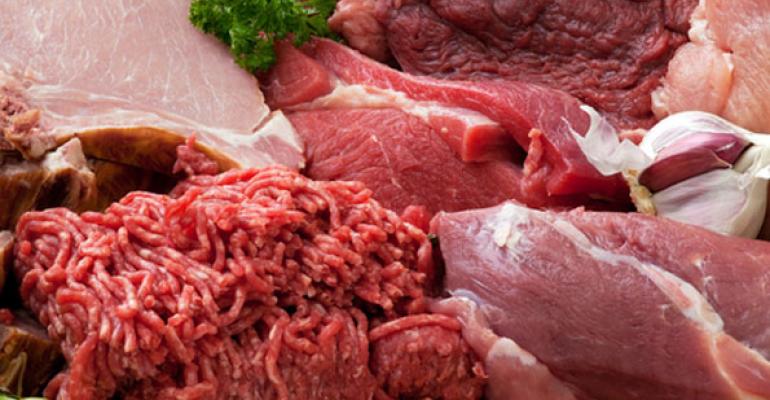WASHINGTON — Supermarket retailers were ready when mandatory nutrition labeling for ground or chopped meat and poultry products, and popular cuts of meat, went into effect on March 1.
In a spot check around the country, SN learned that retailers had worked — often with help from their suppliers — to meet the deadline that the U.S. Department of Agriculture’s Food Safety and Inspection Service had moved forward from its original date of Jan. 1, 2012.
Some retailers were ready with on-pack labels for ground and chopped product and with POS materials for the other USDA-designated cuts of meat by USDA’s original deadline, Jan. 1, or before. Others needed the time to get ready, but were in compliance by March 1, and some ran into technical snags that put them back a day or two.
Nonetheless, as of last week, retailers that SN spoke with said they’re all set.
“We had just put in a brand new meat department last year, and the new scales we bought — Ishida — had the capability to produce the [NutriFacts] labels,” said Bryan Devoe, co-owner of Fitzgerald’s Foods, Simsbury, Conn.
Stauffers of Kissel Hill, based in Lititz, Pa., made good use of the extra time to get ready, said John Gerlach, meat buyer and supervisor for the three-unit independent.
“We got our scales system set to provide the NutriFacts panels, but we ran into a little trouble with the size, and getting all the required information on it,” Gerlach said.
“We needed to get everything on there, and still make the label no bigger than necessary. Our technical people have got it figured out now.”
Gerlach said, too, that his company has posters up offering nutrition information for the other USDA-designated cuts of meat that come under the mandatory rule. But he said in time they’ll make better-looking posters and other POS materials.
Gerlach pointed out that the USDA has a site at which posters are available for downloading.
“We’re using some of those and with the help of our supplier, Associated Grocers here in Pennsylvania, we put them on foam board and had them laminated.”
Gerlach admitted it was challenge to pull it all together, but that it serves customers who want the information, and except for the initial calculations and data-input, the whole thing has not been very costly.
“Any difference [with cost and retail price] has been minimal. We had to review all our processes, and I think we’re better for it today. We always try to be proactive.”
Meanwhile, at seven-unit Broulim’s Fresh Foods, Rigby, Idaho, Corporate Meat Supervisor Mike Smith gave much credit to his supplier, Associated Foods, for helping Broulim’s get ready for the mandatory labeling.
“Fortunately we were prepared before this law went into effect,” Smith said. “Associated Foods, our supplier, was very proactive in talking about this with retailers and even provided training meetings on what would be required.”
Smith added that Broulim’s has been using labels with nutrition facts on its ground meat packages since the first of the year.
“Fat and lean content information on ground meats has always been a priority with Broulim’s, and we have also had nutrition charts on our cases for several years.”
Nutrition labeling for raw meat and poultry had been voluntary until Jan. 1, when USDA’s mandatory ruling was to go into effect.
The Federal Register notice announcing the rule was published on Dec. 29, 2010.
Prior to January, however, a coalition of trade groups urged USDA to extend the deadline for mandatory compliance to March 1, which coincidentally, kicked off National Nutrition Month.
The National Cattlemen’s Beef Association, a member of the trade group coalition, has long been an advocate of providing additional nutrition information on beef products. In fact, funded by the Beef Checkoff program, NCBA conducted successful pilot studies in which labels on fresh beef contained micro-nutrients as well as other nutrients. In each case, significant sales increases were recorded and customers said they appreciated the informative labeling.
In response to nutrition labeling becoming mandatory, NCBA’s response was particularly positive.
“At long last, Americans will have the information they’ve been asking for about the variety of nutrients available in beef right at their fingertips in the store,” NCBA Director of Public Relations Meghan Pusey told SN last week.
“For more than 20 years, we have invested [Beef] Checkoff dollars to help retailers implement nutrition labeling programs and provide information to consumers through websites and educational materials,” she added.
Retailers SN spoke with said they had received little or no feedback from customers about the new nutrition labeling so far.
In addition to NCBA, the coalition of trade organizations that has worked with the USDA on nutrition labeling includes the American Lamb Board, the American Meat Institute, the Food Marketing Institute, the National Chicken Council, the National Grocers Association, the National Pork Board, the National Pork Producers Council and the National Turkey Federation.




